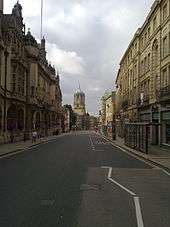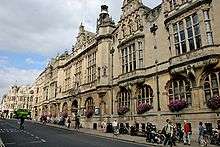St Aldate's, Oxford


St Aldate's /ˈɔːldeɪts/ is a street in central Oxford, England.[1][2] It is named after Saint Aldate of whom little is known, although it has also been suggested that the name is a corruption of 'old gate', referring to the south gate in the former city walls. St Aldate's Church is on the west side of the street, in Pembroke Square. A former name for St Aldate's is Fish Street.[3]
The street runs south from the generally acknowledged centre of Oxford at Carfax. The Town Hall, which includes the Museum of Oxford, is on the east side of the street. Christ Church, with its imposing Tom Tower, faces the east end of St Aldate's, while Pembroke College (on Pembroke Square) faces its west end. Other adjoining streets include Blue Boar Street to the east side and Pembroke Street, Pembroke Square, Brewer Street, Rose Place, and Speedwell Street to the west.
Opposite Christ Church is Alice's Shop, formerly frequented by Alice Liddell, and the model for the Sheep Shop in the "Wool and Water" chapter in Through the Looking-Glass.[4]

South of Christ Church is an entrance to Christ Church Meadow and, still on the east side, the University of Oxford's Faculty of Music, containing the Bate Collection of Musical Instruments; the building was opened in 1936 for St Catherine's Society. Oxford's police station (designed in 1936 by H. F. Hurcombe, the City Estates Surveyor,[1] and the Crown and County Court opposite precede a junction with Thames Street to the west. (The police station was featured in the Inspector Morse television series.) After Folly Bridge over the River Thames or Isis, St Aldate's becomes Abingdon Road (A4144), leading directly south out of the city of Oxford towards the Oxford Ring Road and the villages of Kennington & Radley and the town of Abingdon.
Gallery
-

The northern end of St Aldate's.
-
Alice's Shop on St Aldate's, opposite Christ Church.
-
Tom Tower and the main entrance to Christ Church, the largest Oxford college, on St Aldate's.
-

Oxford Town Hall on St Aldate's.
-

The High and Cornmarket streets intersection at the far northern end of St Aldate's.
-

St Aldate's Street from the Speedwell Street entrance, adjacent to the Bate Collection of Musical Instruments in Christ Church Park.
-

View of St Aldate's longing north from Folly Bridge with The Head of the River public house on the right.
-

Looking south down St Aldate's in the snow, with Christ Church on the left.
References
- 1 2 Sherwood, Jennifer; Pevsner, Nikolaus (1974). The Buildings of England: Oxfordshire. Harmondsworth: Penguin Books. pp. 128, 181, 232, 287, 301, 302, 303, 325. ISBN 0-14-071045-0.
- ↑ Tyack, Geoffrey (1998). Oxford: an architectural guide. Oxford University Press. pp. 2, 22, 243, 291, 297, 307. ISBN 0-14-071045-0.
- ↑ Street-Names, A History of the County of Oxford. Vol. 4, The City of Oxford (1979), pp. 475-477.
- ↑ Gardner, Martin (1965). The Annotated Alice. Harmondsworth: Penguin Books. p. 252.
External links
- Oxford Guide information
- St Aldate's Church
- St Aldate's Post Office
- Oxford's Town Halls in St Aldate's
Coordinates: 51°45′00″N 1°15′25″W / 51.75000°N 1.25694°W

